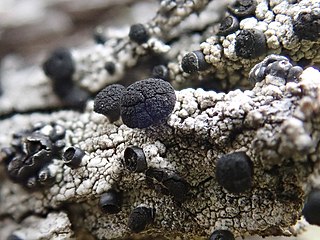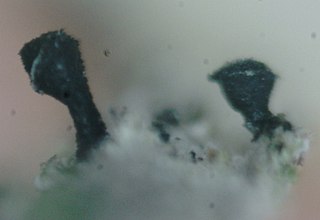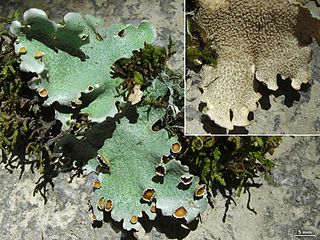
Acolium is a genus of lichenized fungi in the family Caliciaceae. The genus has a widespread distribution and contains six species. These lichens are found on bark and wood, occasionally on rocks, or growing on other lichens.
Calopadia cinereopruinosa is a species of corticolous (bark-dwelling) lichen in the family Pilocarpaceae. Found in the Galápagos Islands, it was described as new to science in 2011. It is characterized by its grey-black, white-pruinose apothecia and aeruginous hypothecium. This lichen usually grows on the bark of stems and twigs in the humid zones of the islands.

Calicium abietinum, commonly known as fir pin or black stubble, is a crustose lichen that is found growing on trees throughout much of the world.

Calicium glaucellum is a crustose lichen that is found growing on trees throughout much of the world. The species is similar to Calicium abietinum.
Filsoniana rexfilsonii is a species of saxicolous (rock-dwelling), crustose lichen in the family Teloschistaceae. Found in Australia, it was formally described as a new species in 2007. The thallus of Filsoniana rexfilsonii comprises brownish-orange squamules each hosting one to four reproductive structures.
Cratiria sorediata is a species of corticolous (bark-dwelling), crustose lichen in the family Caliciaceae. It was first described as a new species in 2009. The type specimen was collected from Aldabra in the Seychelles.
Pyrrhospora palmicola is a species of corticolous (bark-dwelling), crustose lichen in the family Lecanoraceae. It has a yellow thallus with rounded to irregular apothecia with pale brown or black discs. The lichen is found in Mato Grosso, Brazil, and the Seychelles.
Sirenophila cliffwetmorei is a species of saxicolous (rock-dwelling), crustose lichen in the family Teloschistaceae. It is found in Australia. Its thallus can reach up to 1 centimetre in width, has a whitish to whitish-grey colour, and is very thin, sometimes almost merging with the substrate, and has paler edges with a darker grey centre. Its numerous tiny apothecia give the thallus a yellow-orange appearance.
Lecidea lygommella is a species of saxicolous (rock-dwelling), crustose lichen in the family Lecideaceae. It spreads up to 7 cm wide with a thin thallus varying in colour from whitish and pale grey to rusty red-brown, featuring areolate surfaces with irregularly shaped areoles. Its fruiting bodies range from slightly embedded to sitting atop the thallus and black, flat to slightly convex apothecial discs. Unlike its lookalike Lecidea lygomma, L. lygommella does not produce any secondary chemicals. It is found in New South Wales and Victoria, Australia, where it grows on rocks in alpine areas.
Malmidea cineracea is a little-known species of corticolous (bark-dwelling), crustose lichen in the family Malmideaceae. It is found in Nicaragua.
Placolecis kunmingensis is a species of saxicolous (rock-dwelling), crustose lichen in the family Catillariaceae. It is found in Yunnan, China. The lichen is characterised by a thallus that is areolate to squamulose in its centre, forming irregular patches or clumps 10–50 mm wide, as well as its ellipsoid or spherical ascospores with slightly thickened wall.
Placolecis sublaevis is a species of saxicolous (rock-dwelling), crustose lichen in the family Catillariaceae. It is found in Yunnan and Sichuan, China. The crust-like, radiating body of the lichen forms irregular patches or clumps and includes numerous false conidiomata, a type of asexual reproductive structure, within its thallus. Its lobes, dark brown and slightly flattened at the top, form larger groups at the edges and contain an upper layer composed of loosely interwoven cells and a lower inner tissue that varies from reddish-orange to white.
Amandinea pilbarensis is a little-known species of crustose lichen in the family Physciaceae, First described in 2020, it is found in Australia. It is similar to Amandinea polyxanthonica, but can be distinguished by its smaller ascospores and the presence of calcium oxalate and thiophanic acid in the medulla.
Byssoloma xanthonicum is a species of corticolous (bark-dwelling), crustose lichen in the family Pilocarpaceae. It is found in New Caledonia.

Lobariella reticulata is a species of foliose lichen in the family Peltigeraceae. It is found in Colombia.
Fellhanera ivoriensis is a species of foliicolous (leaf-dwelling) lichen. First described in 2001, this species is distinguished from its relatives in the Fellhanera by its soredia-covered thallus and the characteristics of its apothecia. It is native to the Ivory Coast in West Africa.
Flavoplaca kantvilasii is a species of saxicolous (rock-dwelling), crustose lichen in the family Teloschistaceae. Found in Australia, it was formally described as a new species in 2007.
Filsoniana ferdinandmuelleri is a species of saxicolous (rock-dwelling), crustose lichen in the family Teloschistaceae. It is found in Australia. The lichen has a squamulose (scaly) thallus, with a range of bright yellow to greenish-yellow and brownish-orange colours in its soredia and apothecia, respectively. The areoles of this lichen are varied in size, slightly raised from the thallus surface, and each carries one to four apothecia. The soralia are rounded or irregularly shaped, covering most of the thallus surface as a yellow to greenish-yellow mass. The apothecia have dark brownish-orange discs, surrounded by slightly paler yellow margins, with the spore-bearing asci containing typically eight brownish-golden ascospores.
Hanstrassia lenae is a species of saxicolous (rock-dwelling) in the family Teloschistaceae. Described as a new species in 2007, the lichen is found in Russian Far East, Mongolia, and Siberia. It closely resembles Elenkiniana ehrenbergii but distinguished by the presence of soralia on its thallus. This species has a thick, effigurate thallus with weak marginal lobes and developed marginal, labriform (lip-shaped) soralia.

Baeomyces heteromorphus is a species of terricolous (ground-dwelling) lichen in the family Baeomycetaceae. It has an Australasian distribution. Characteristics of the lichen include its greenish-grey thallus, the pink to brownish discs of its apothecia, translucent spores lacking internal partitions (septa), and the presence of the secondary metabolites norstictic acid and connorstictic acid.




